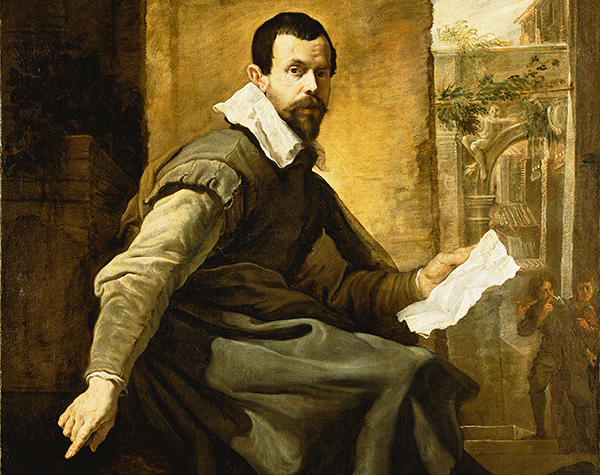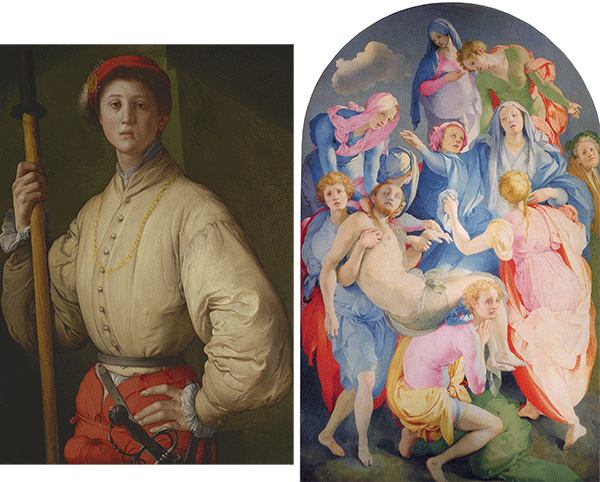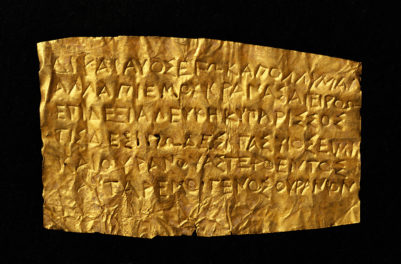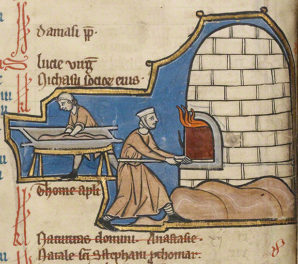
Davide with one of his favorites, Vittore Carpaccio’s Hunting on the Lagoon
Dr. Davide Gasparotto arrived at the Getty Museum a few months ago from Modena, Italy, where he was the director of the Galleria Estense, a museum of Italian paintings from the 14th to 18th centuries. Gasparotto formerly served as curator at the National Gallery in Parma, and was a visiting fellow at both the Center for Advanced Study in the Visual Arts at the National Gallery in Washington, D.C., and the Metropolitan Museum of Art. The author of many books, his areas of interest include painting, sculpture, and the decorative arts of the Renaissance, the rediscovery of classical antiquity between the Middle Ages and the 18th century, and the history of collecting, particularly in the Italian Renaissance.
His first exhibition will open this fall at the Getty Center and focus on the opulent styles and intricate craftsmanship of frames made in France during the 17th and 18th centuries. We talked to Davide about his origins as an art historian, his favorite works at the Getty, and his plans for the future.
Lyra Kilston: When did you first become interested in art history?
Davide Gasparotto: When I was 12 years old I read The Discovery of the Tomb of Tutankhamen by Howard Carter, so my first art historical interest was in ancient Egypt. My first university degree was in the history of the classical tradition, and my passion for ancient cultures remains very strong.
Was there a particular object, artist, museum, or moment that convinced you this was your life’s work?
My parents often took my brothers and me to visit museums, churches, and the many villas by Palladio near our hometown of Bassano del Grappa in the heart of the Veneto region. But a crucial turning point was when I was 16 years old and visited a great exhibition held in the Ducal Palace in Venice called From Titian to El Greco. It was a stunning show, leading me to discover the world of the great Venetian painters of the High Renaissance: Titian, Veronese, and Tintoretto.

Portrait of a Man with a Sheet of Music (detail), about 1620, Domenico Fetti. Oil on canvas, 68 x 51 1/8 in. The J. Paul Getty Museum, 93.PA.17
What drew you in particular to the Italian Renaissance?
In some ways it was a natural choice, given the fact that I grew up in an environment where Renaissance art is very well represented. But when I was in high school I read the book on Giorgione’s Tempest by Salvatore Settis, who later became my professor at university. I glimpsed a much more complex and profound way to look at a great work of art, not only from a purely aesthetic point of view, but from a broader historical, social, and cultural context. It was a revelation of the many layers through which you can approach a historical work of art, and how much a painting can tell you about the aspirations, beliefs, and ideals of people who lived in the very distant past.
You made a big move from Italy to Los Angeles for this position. What made you want to work at the Getty?
The Getty has a great reputation all over the world, not only as a museum but also as a very lively scholarly community. I think the presence of the different institutes—the Museum with its wonderful collections, the Foundation with its many projects, the Research Institute with its incredible resources for research and its many visiting scholars, the Conservation Institute for conservation programs—makes the Getty a unique and very special place.
As you know, in Italy we have some of the most beautiful museums in the world, but we do not have a place where the life of a museum curator can be enriched and stimulated by the presence of these other related fields of scholarship. I think that it was mainly this aspect that convinced me to cross an ocean and a continent to come here.

The “irresistible” Statuette of Venus, Greek or Roman, 1st century B.C. Rock crystal, 3 3/8 in. high. The J. Paul Getty Museum, 78.AN.248
Can you name a few artworks in the Getty collections that you are happy to be neighbors with now?
Oh, there are many! Among the paintings I love are the poetry of Carpaccio’s Hunting on the Lagoon, the melancholy of the Portrait of a Man with a Sheet of Music by Domenico Fetti, the power of Rubens’s Entombment, the humor of Jan Steen’s The Drawing Lesson, and the epic sense of a glorious past in Turner’s View of Ancient Rome. Among the sculptures I have a particular passion for Riccio’s Virgin and Child in terracotta and for Francesco Mochi’s gilt-bronze relief Tabernacle Door with Crucifixion. Among the antiquities, there is a small Statuette of Venus in rock crystal that I find irresistible.
What is your vision for future exhibitions and the development of the collection?
For acquisitions I hope to follow the example of my illustrious predecessors, which is to buy only great works of art. There are still gaps in the collection, and the aim is to give a broad picture, at the highest level of quality, of the development of European painting from the Middle Ages through the end of the 19th century. But I think that the agenda will be mainly dictated by the availability of really important paintings on the market.
Concerning exhibitions, my idea is to develop projects—alongside my excellent team of curators—that will have as a core the paintings from our own collection. Personally I prefer “contextual” shows in which different media are mixed—paintings, sculptures, drawings—and so I hope to work in close collaboration with my distinguished colleagues from other departments.
One of your areas of interest is the rediscovery of classical antiquity between the Middle Ages and the 18th century. Do you see the Getty Villa, which is inspired by the ancient Villa dei Papiri, as an extension of this impulse?
Yes, definitely. J. Paul Getty’s will to recreate the famous villa in Herculaneum on the coast of the Pacific Ocean is not only a tribute to the enduring heritage of classical antiquity, but can be compared to the desire of Emperor Hadrian to build a villa in which the most famous buildings of Athens were evoked, or to the ambition of cardinal Giulio de’ Medici, who commissioned Raphael to design a villa for him on the hill of Monte Mario in Rome following the model of the ancients. The difference, fortunately for us, is that J. Paul Getty envisaged this building not to be exclusively a private retreat, but a public museum with an educational purpose and mission.

A fantasy pairing of Pontormos. Left: Portrait of a Halberdier, 1528–30, in the collection of the J. Paul Getty Museum. Right: The Deposition from the Cross, 1528, in the church of Santa Felicita in Florence, Italy.
If an unlimited budget and loan approval were guaranteed, what would be your ultimate curatorial project?
A major retrospective on Pontormo, one of my favorite Renaissance artists and one of the greatest painters and draughtsmen who ever lived. The Museum has one of his masterpieces, Portrait of a Halberdier. Unfortunately it would be impossible to have the Deposition of Christ loaned from the church of Santa Felicita in Florence—one of the most moving paintings from all of art history.




Davide,
Welcome to the Getty!
How nice to see Dr. Gasparotto and read his comments on art in Italy and at the Getty. I must say I feel he will bring a fresh approach to some of the coming shows. Thank you for the introduction !
Welcome to California and the Getty Mr. Gasparotto! How wonderful to have your Italian influence on the collection at the Getty. We love viewing the stunning paintings and other works of art from times past, however we notice that most museums never include explanations of the artist’s methods. Although it may not be possible to always ascertain how the artist worked – with thin layers, with many under drawings, with brushes/knives/sticks/feathers, from right to left, from top to bottom, painting the face first then adding other elements etc. – it’s so interesting to know these details. Please consider examining a few works and presenting information on the pigments used and the style in which the artist worked. Thank you, and again welcome!
I appreciated this interview, particularly the notion of presenting exhibitions in which the Getty’s own paintings are put into contexts with those from other collections. Repeat visitors, it seems to me, may reflexively gravitate to the Impressionist works because they, their artists, and that artistic school are widely-recognized and therefore somehow more intellectually and emotionally accessible. Some of the earlier works, including those mentioned in the interview, may seem less so because less is known about them by even those of us who visit the Getty several times a year. The Turner exhibition, coupled with a heavy boost from the eponymous film, will undoubtedly move the Getty’s two Turners into the same category as the Impressionist collection. Many people will now always want to take another look. Exhibitions which help lure visitors to other parts of the museum on a repeat basis could go a long way towards educating viewers about many of your other outstanding works and enhance the richness of their return visits to your collection. Context also can be supplied through vehicles other than other works by the same or contemporaneous painters. One of the best exhibits I ever attended was a show curated at the Guggenheim focused on similar subjects and themes as portrayed by by Velasquez, Goya, and Picasso. It made me appreciate all three, and Spanish art history, in ways I had not before. Congratulations to Dr. Gaspararatto for such an auspicious and intelligent start.
Thank you for your comments! We will pass them a long to Davide.
Hi Davide. My warmest congratulations! Regard to Otto.
All the best. Amedea and Adrian
Thanks for a fascinating, informative, warmly personal interview.
How fortunate for us and for the art world that Dr. Gasparotto and The Getty are coming together, a winning combination for the Museum community.
Bravo, Davide! Fai onore a tutti noi del vecchio Brocchi!
Cristina
Welcome to LA. I just came back to LA after many years as Vice Consul at Consulate General of Italy, and this great news, to have you with us, make me proud to be Italian. I recently visited at Getty the new installation of Egypt civilization, it is a superb work. Congratulation.
Spero incontrarla presto.
Felicitazioni
Mariella
Dear Davide Gasparotto,
I have seen the Pontormo Visitation at the Morgan five times because I liked it so much. I saw it last on the day that it closed, and that night while watching reruns of The Sopranos, saw a reproduction on the bedroom wall of the mobster Tony and his wife Carmela Soprano. Found this completely astonishing and wonder if you know about it.